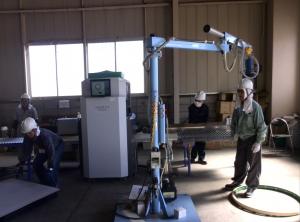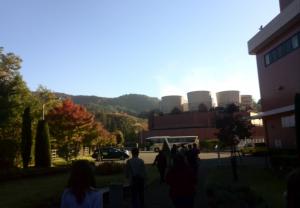The first place we visited was a facility for testing radiation levels in locally-produced rice. Bags of rice were passed through a machine which scanned them. The work is pain-staking: the thirty-kilogram bags are passed through the radiation scanner one by one, and then each is given its own barcode label for identification. So far, not a single bag has scanned even close to the upper radiation limit that would prevent it from being sold. After lunch, we toured a geothermal power station. Impressively, the entire facility could be managed remotely by a small group of workers on a separate site. Later in the afternoon we went on to visit Enzo-ji, a Buddhist temple that is home to the akabeko - the red cow that has come to be the symbol of Fukushima. That night we stayed with local families in groups of three or four. With two others, I stayed in a ryokan - a traditional Japanese inn - owned by a local couple. We were treated to a great deal of food (and nihonshu) that evening, and had the chance to tour some of the surrounding farmland the next day. It was fascinating to see a little of daily life in this rural and relatively remote part of the prefecture. The following morning we listened to a presentation on IIE, a local business that makes and sells fabric products from scarves to dishcloths to coasters. It was set up by a group of people evacuated to Aizu after the earthquake. For local women in particular, it has offered a way of doing something for their community activities and putting creativity to good use. Our final port of call was Tsurugajo, the famous castle in Aizuwakamatsu-shi. Besides touring the fortress itself, we met a member of staff who filled us in on how the earthquake has effected tourism in the region. In previous years, Tsurugajo was accustomed to receiving thousands of tourists from Japan and overseas the year round. But visitors numbers plummeted immediately after the disaster and, although they have partially recovered since then, still stand well below their volumes before the earthquake. It was this, to me, that most neatly illustrated the challenge that Fukushima Prefecture now faces. The 2011 earthquake caused damage to Fukushima’s reputation as well as physical damage; some still feel the effects of both today. This was a tour that truly underlined that Fukushima encompasses a huge range of landscapes, activities and people. I was consistently impressed by the optimism and energy with which people had taken to the task of re-building their communities. I hope that we as members of JET Programme can make a difference by promoting this positive image of Fukushima in our home countries. |
| Summary |









